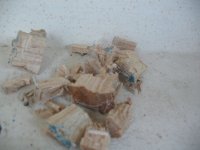Coach T":1lyqn3tq said:
I have found a leak in my forward hatch. I believe the leak is from one of the top side screws. My plan is to dismantle the hatch and reinstall with 100% silicone between the top flange and the fiberglass. In doing this I plan to silicone each screw when reinstalling. I also found that the leak is not new, when I took the inside flange off I noticed some black/dark wood.
Here are my thoughts:
Good on you for tackling this now, before it becomes a larger problem :thup
First off, I detest silicone, so I would 100% not use it. Here is why: First, it doesn't tend to do the best sealing job. Second, it is the absolute devil :amgry to ever get off. Third, it will leave an invisible, nearly impossible to remove layer of contamination, that means no silicone, other caulk, paint, tape, or really anything will ever stick to the area again. This makes a re-caulking job that would normally take a pleasant half hour (or whatever) take days of cursing, scratching things, sanding, destroying, etc. Yes, I'm not a fan :wink:
So okay, now that I have got that off my chest.
It sounds like you have enough moisture or potential issues that you should remove the hatch if you can. Then you can really see what you are doing, clean things up, protect the core, and then re-bed the hatch and the screws. Here is what I would do (presuming what you are describing is what I'm mentally seeing) (have just been doing my own hatch, actually).
Note that there are many ways to do epoxy work, and many of them are "right." There is just variation in the little tips and tricks that various people use to do it.
1) Remove hatch. Clean up hatch flange and deck of boat where it will be going back (I hope silicone was not used originally!)
2) Using a Dremel, dental pick, or etc. remove the core from around the hatch edge back 3/4" or so (or if there is moisture, get all the wet core out). You can include the screw holes in this, so that when you fill it does it all. Sand the newly exposed deck skins (inside where you removed core).
3) Vacuum things out and then wipe down with denatured alcohol.
4) Tape things off six ways from Sunday so as to avoid having to clean up epoxy messes.
5) Wipe down again just to be sure.
6) Wet out all the inside areas with neat (unthickened) epoxy.
7) Fill it all with thickened epoxy*, taking it in stages if you have any huge areas, or it is very hot out (because otherwise it will get really hot and can cause a problem as it cures)
8 ) While the epoxy is in the green stage (hard cheese/rubbery texture - not actual color) trim it back with a utility knife or etc so it's about like how you want it in the end (easier to do this now than sand later).
9) After it has cured, wipe it down with water (only) and a scotch brite pad to wash off any "blush."
10) Replace hatch with appropriate bedding compound (not silicone!)
11) Re-bed and replace screws. I'm actually going to tap mine and use machine screws (I don't get a warm fuzzy feeling from pointy screws into fiberglass) but pointy would likely work fine as well. You'll have to make your pilot holes a bit larger than you would for wood.
12) Remove tape and be happy you spent extra time masking off earlier vs. cleaning up now

Sunbeam
* On the thickened epoxy: I have developed quite a fondness for WEST's 610 product. This is a pre-thickened epoxy that comes in a caulking tube and is a joy to work with (yes, really). Expensive, but you're not building a boat with it. It taps well, and has this thing they call "shear thinning" where it is really smooth and workable while you are manipulating it, but then stays put and is stiffer when you stop. You can use the mixing tips that go with it (I often gun it right into a syringe for screw holes, etc.), or just mix it by hand and use it with a popsicle stick, etc.
WEST say you do not need to pre-wet-out with neat epoxy when using this, but I usually still do (absolutely below the waterline). But then I have plenty of epoxy on hand.
If you are mixing your own, I tend to use colloidal silica to thicken it for this sort of application.
PS: I forgot you asked about brands, etc. I would use any of the "good" marine epoxies (not JB Weld, hardware store 5-minute epoxy, or etc.). Some brand names include WEST System, System Three, and MAS. They also sell the thickeners (which are interchangeable between brands). That said, for this I would recommend the WEST 610 in the tube for ease of use and lack of need to buy a bunch of extra stuff/learning curve, etc. I would buy (or have on hand) the following:
WEST 610 tubes and mixing tips
Caulk gun (you may already have)
Box of non-powdered disposable nitrile gloves
Tongue depressors
(I make homemade spreaders out of cut up gallon water jugs)
Blue tape, 2"
Denatured alcohol
Paper towels
Syringes (WEST make some) if you need to do any separate holes (you may not if you include them in the main excisement).
Acid brushes or the like if you are going to be "painting on" neat epoxy.
Dremel with sanding drums, or 115 bit; dental pick, or some other way to dig out core.
Sandpaper
Vacuum
I've probably forgotten something, but this is a start at any rate.

